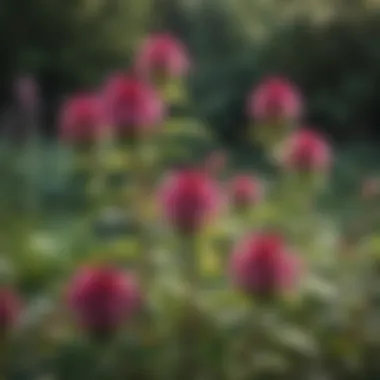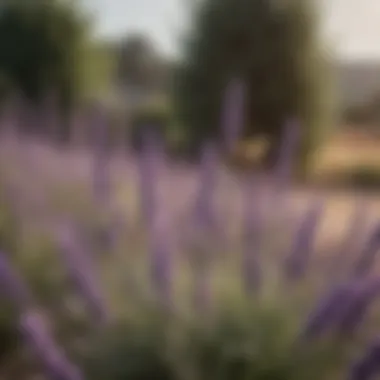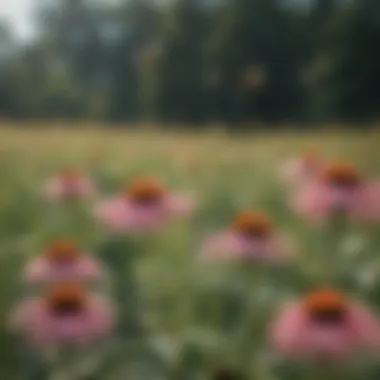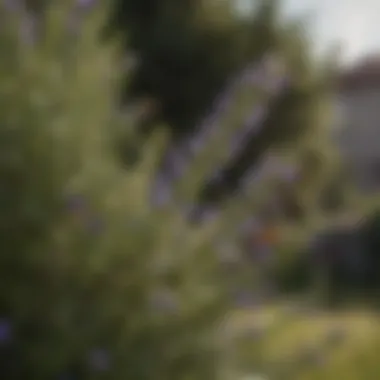Unlocking the Secrets of Bee-Friendly Bushes for a Thriving Garden Ecosystem


Article Continues Below
Introduction
In the realm of gardening, the selection of bushes holds a profound significance, particularly when considering their impact on bee populations and the overall ecosystem of your garden. Choosing the right bushes can transform your outdoor space into a vibrant hub of biodiversity and sustainability. By understanding the crucial role that bees play in pollination, gardeners can appreciate how incorporating bee-friendly bushes is not merely a choice of aesthetics but a fundamental step towards environmental stewardship and ecosystem health.
Understanding the Impact of Bees in Gardening
The Essential Role of Bees in Pollination
Bees stand as nature's diligent pollinators, moving from flower to flower in a delicate dance of transferring pollen grains necessary for plant reproduction. The symbiotic relationship between bees, flowers, and plants is the very foundation of a thriving garden ecosystem. Their precision in pollination ensures the continued growth, diversity, and resiliency of plant communities, making them an irreplaceable asset in gardening. The characteristic efficiency of bees in pollination is not only remarkable but essential in sustaining not only floral beauty but also the very existence of many plant species.
The Decline of Bee Populations and Environmental Concerns
Yet, the alarming decline of bee populations poses a significant threat to global biodiversity and food security. Environmental concerns, including habitat loss, pesticide use, and climate change, contribute to this unsettling trend. Acknowledging the decline of bee populations is crucial in highlighting the urgency of preserving and supporting these vital pollinators. To address this issue, promoting bee-friendly gardening practices becomes imperative to safeguard not just bees but the holistic health of our ecosystems.
Benefits of Incorporating Bee-Friendly Bushes in Your Garden
Enhancing Ecosystem Diversity
The integration of bee-friendly bushes enriches the landscape, fostering a diverse array of plant species and pollinators. By welcoming bees into your garden through strategically selected bushes, you invite a harmonious symphony of biodiversity that transcends mere visual aesthetics. This diversity not only enhances the resilience of your garden ecosystem but also contributes to the overall health of surrounding flora and fauna.
Supporting Bee Health and Well-Being
Elevating bee health through the provision of suitable foraging opportunities is a cornerstone of bee-friendly gardening. Incorporating bushes that offer ample pollen and nectar sources sustains bee populations, ensuring their well-being and vitality. By catering to bees' nutritional needs, gardeners can actively participate in bolstering these essential pollinators, thereby creating a mutually beneficial relationship with nature.
Boosting Plant Productivity Through Pollination
The intricate process of pollination facilitated by bees significantly boosts plant productivity within gardens. As bees transfer pollen grains between flowers, they catalyze fruit and seed production, ultimately fostering a flourishing garden. This natural phenomenon not only enhances the yield of garden crops but also elevates the overall ecological balance, underscoring the immense value of bees in agricultural and horticultural contexts.
Criteria for Selecting Bushes for Bees
Choosing the right bushes for bees is a crucial decision that can significantly impact your garden ecosystem. By understanding the intricate needs of bees and the role bushes play in supporting their populations, you can create a flourishing habitat that fosters biodiversity. When selecting bushes for bees, certain key criteria should be considered to ensure optimal benefits. These criteria encompass aspects such as whether to opt for native or non-native plants, the flowering period and diversity of the bushes, and the importance of pesticide-free cultivation methods.
Native vs. Non-Native Plants


When deciding between native and non-native plants for your garden, it is essential to weigh the impact on local ecosystems. Native plants have evolved alongside local wildlife, including bees, making them better suited for supporting regional biodiversity. Their adaptability to the climate and soil conditions of the area ensures a more sustainable choice for your garden. On the other hand, non-native plants may offer exotic beauty but could potentially disrupt the delicate balance of the ecosystem. While they may be visually appealing, their lack of adaptation to local conditions could pose challenges for bees and other native pollinators.
Impact on Local Ecosystems
Native plants play a critical role in maintaining the delicate balance of local ecosystems. Their presence supports native wildlife, including bees, by providing familiar food sources and habitats. By choosing native bushes, you contribute to the preservation of indigenous flora and fauna, creating a harmonious environment that benefits pollinators and other wildlife. Non-native plants, although aesthetically pleasing, may not offer the same level of support to local ecosystems, potentially leading to disruptions in natural habitats and food chains.
Adaptability to Climate and Soil Conditions
The adaptability of native plants to the specific climate and soil conditions of your region is a valuable trait for bee-friendly bushes. Native species have evolved over time to thrive in the local environment, requiring minimal maintenance and resources. Their resilience to environmental factors makes them a sustainable choice for gardeners looking to attract and support bees. In contrast, non-native plants may struggle to cope with the climatic challenges of a new habitat, requiring additional care and resources to survive.
Flowering Period and Diversity
Another important consideration when selecting bushes for bees is the flowering period and diversity of the plant species. Sustaining bee populations throughout the year relies on having a variety of bushes that bloom at different times, providing a continuous nectar and pollen supply. This diversity ensures that bees have access to essential nutrients throughout their foraging season, promoting their health and well-being. A garden with a varied selection of flowering bushes creates a dynamic ecosystem that supports a rich diversity of pollinators.
Sustaining Bee Populations Throughout the Year
Bushes that bloom at different times of the year play a vital role in supporting bee populations year-round. Bees rely on a constant supply of nectar and pollen to meet their nutritional needs, especially during periods of high activity. Ensuring that your garden contains a mix of early, mid-season, and late-flowering bushes helps sustain bee populations by providing continuous food sources. By planning your garden to cater to bees' foraging patterns throughout the seasons, you can create a thriving ecosystem that supports pollinator diversity.
Offering a Variety of Pollen and Nectar Sources
The diversity of pollen and nectar sources available in your garden directly influences the health and productivity of bee colonies. Different bee species have varying preferences for nectar sources, and providing a range of flowering bushes can attract a diverse mix of pollinators. Offering various pollen and nectar options not only ensures a balanced diet for bees but also enhances their resilience to environmental changes. By cultivating a garden with a mix of bushes that cater to different bee species, you create a robust ecosystem that promotes pollination efficiency and bee well-being.
Pesticide-Free Cultivation
Creating a pesticide-free environment in your garden is essential for ensuring the safety and health of bees. Pesticides can be harmful to bees and other pollinators, impacting their foraging behavior, reproduction, and overall well-being. Opting for organic and pesticide-free cultivation practices reduces the risk of exposure to harmful chemicals, creating a safer habitat for bees to thrive. By promoting natural pest control methods and avoiding chemical pesticides, you contribute to a healthier ecosystem that supports biodiversity and bee populations.
Ensuring a Safe Environment for Bees
Eliminating the use of pesticides in your garden helps maintain a safe environment for bees to forage and pollinate. Pesticide residues on plants can be transferred to bees during feeding, affecting their nervous system and immune function. By choosing pesticide-free cultivation methods, you safeguard bees from accidental exposure to toxic chemicals, preserving their vital role in pollination. Creating a pesticide-free zone within your garden demonstrates a commitment to environmental stewardship and the protection of pollinators.
Promoting Organic Garden Practices
Promoting organic garden practices goes beyond eliminating pesticides; it encompasses a holistic approach to sustainable gardening. Organic gardens prioritize soil health, water conservation, and biodiversity, creating a more resilient ecosystem for bees. By adopting organic gardening techniques such as composting, mulching, and natural pest control, you enhance the overall health of your garden and support beneficial insect populations. Organic practices not only benefit bees but also contribute to environmental conservation and long-term ecosystem sustainability.
Top Bushes That Attract Bees
In this article, the focus shifts towards the vital role that bushes play in attracting bees and fostering a thriving garden ecosystem. Selecting the right bushes can significantly impact the presence of bees in your garden, ensuring optimal pollination and contributing to the overall health of your outdoor space. Understanding the characteristics, benefits, and considerations related to bushes that attract bees is essential for any gardening enthusiast looking to create a bee-friendly environment.


Lavender (Lavandula)
Characteristics and Growing Tips
Exploring the specifics of lavender's characteristics and growing tips reveals why it is a standout choice for bee-friendly gardening. Lavender's resilience in various climates and soil conditions makes it a popular selection for those seeking to attract bees. Its aromatic foliage and vibrant blooms not only add visual appeal but also provide bees with a rich source of nectar. Understanding how to cultivate lavender successfully ensures a continuous supply of pollen and nectar for bees throughout the growing season.
Benefits for Bees and Other Pollinators
Delving into the benefits that lavender offers to bees and other pollinators underscores its significance in creating a sustainable garden ecosystem. Lavender's abundant nectar production serves as a valuable food source for bees, supporting their health and well-being. Additionally, the flowers' attraction to other pollinators enhances the ecological diversity of the garden, promoting a harmonious relationship between plants and insects.
Heather (Calluna)
Cultivation Requirements
Examining the cultivation requirements of heather sheds light on its suitability for attracting bees of different species. Heather's preference for well-drained acidic soil and partial sunlight makes it an accessible option for various garden settings. By understanding and adhering to heather's specific cultivation needs, gardeners can ensure a thriving environment that entices bees to forage and pollinate effectively.
Attractiveness to Different Bee Species
Highlighting the attractiveness of heather to different bee species emphasizes its versatility in supporting a diverse pollinator community. Heather's unique floral structure and extended blooming period make it an attractive choice for bees with varying foraging behaviors. By incorporating heather into the garden landscape, gardeners can cater to a broad range of bee species, enhancing pollination efforts.
Sage (Salvia)
Varieties and Planting Guidelines
Exploring the diverse varieties and planting guidelines of sage illuminates its role in promoting bee activity and foraging behavior. Sage's multiple cultivars offer a spectrum of colors and growth habits, providing options for gardeners to design bee-friendly spaces creatively. Planting sage strategically not only enhances the visual appeal of the garden but also influences bee foraging patterns, encouraging consistent visits for pollination.
Impact on Bee Foraging Behavior
Understanding the impact of sage on bee foraging behavior underscores its significance in sustaining bee populations and ecosystem health. Sage's rich nectar content and pollen-producing capabilities attract bees and support their foraging endeavors. By observing bee interactions with sage plants, gardeners can optimize garden layouts to maximize pollination efficiency and promote a thriving bee habitat.
Butterfly Bush (Buddleja)
Flowering Patterns and Maintenance Tips
Exploring the flowering patterns and maintenance tips of the butterfly bush reveals crucial insights into its role in bee gardening. The butterfly bush's unique blooming cycles and pruning requirements influence its appeal to bees and the overall garden aesthetics. By following recommended maintenance practices, gardeners can ensure continuous flowering periods that sustain bee populations and enhance the garden's visual allure.


Drawbacks and Considerations for Bee Gardening
Examining the drawbacks and considerations associated with the butterfly bush offers a balanced perspective on its integration into bee-friendly gardens. While the butterfly bush attracts bees with its fragrant blooms, it may pose challenges related to aggressive growth or maintenance demands. By weighing the benefits against the potential drawbacks, gardeners can make informed decisions when incorporating the butterfly bush into their garden landscapes.
Creating a Bee-Friendly Garden Oasis
Creating a Bee-Friendly Garden Oasis is an essential element in our exploration of enhancing garden ecosystems through bee-friendly bushes. By strategically designing our outdoor spaces to attract bees, we not only contribute to the overall health of the ecosystem but also create a visually appealing and sustainable garden environment. This section will delve into the significance of intentional garden design in supporting bee populations and fostering a harmonious relationship between nature and our living spaces.
Designing Your Outdoor Space to Attract Bees
Strategic Plant Placement
Strategic plant placement is a pivotal aspect of creating a bee-friendly garden oasis. By carefully selecting and situating flowering plants and bushes, we can maximize their attractiveness to bees while promoting efficient pollination. The key characteristic of strategic plant placement lies in its ability to ensure a continuous and diverse supply of pollen and nectar throughout the blooming seasons, catering to the varying dietary needs of different bee species. This deliberate placement is a strategic choice for our article as it plays a crucial role in supporting bee foraging patterns and enhancing overall pollination rates. However, one potential drawback of strategic plant placement is the challenge of maintaining a balance between aesthetic appeal and bee-friendly functionality.
Providing Water Sources for Bees
Providing adequate water sources for bees is another critical aspect of creating a bee-friendly garden oasis. Ensuring that bees have access to clean and fresh water helps in maintaining their hydration levels, especially during hot and dry periods. The key characteristic of providing water sources for bees is its ability to attract and retain bee populations within the garden, enhancing their foraging and pollination activities. This practice is a popular choice for our article as it promotes bee health and well-being, contributing to the sustainability of the ecosystem. One unique feature of providing water sources for bees is the opportunity to observe and study bee behavior around these resources, allowing for insights into bee habits and preferences. However, a potential disadvantage of this practice is the extra maintenance required to prevent water stagnation and mosquito breeding.
Maintenance and Care for Bee-Friendly Bushes
Maintaining and caring for bee-friendly bushes is crucial in ensuring the long-term sustainability of a bee-friendly garden oasis. Proper pruning techniques help in promoting plant health and longevity while monitoring bee activity and health allows us to gauge the effectiveness of our gardening efforts in supporting bee populations. This section will address the significance of these practices in preserving the delicate balance between human habitation and a thriving bee ecosystem.
Pruning Techniques
Pruning techniques play a key role in maintaining bee-friendly bushes and promoting their growth and blooming. By removing dead or diseased branches and shaping the bushes for optimal sunlight exposure, we can enhance their vigor and productivity. The key characteristic of pruning techniques is their ability to rejuvenate bushes, stimulate new growth, and improve overall plant structure, making them a beneficial choice for our article. However, one potential disadvantage of improper pruning techniques is the risk of damaging the bushes and compromising their ability to attract bees and other pollinators.
Monitoring Bee Activity and Health
Monitoring bee activity and health provides valuable insights into the impact of our gardening practices on bee populations. By observing bee behavior, tracking visitation patterns, and seeking early signs of disease or stress, we can take proactive measures to support bee well-being. The key characteristic of monitoring bee activity and health is its role in gauging the success of our bee-friendly garden oasis and identifying areas for improvement. This practice is a popular choice for our article as it highlights the importance of maintaining a vigilant eye on bee populations within our gardens. One unique feature of monitoring bee activity and health is the opportunity to collaborate with local researchers and bee experts to contribute valuable data to ongoing conservation efforts. However, a potential disadvantage of this practice is the time and effort required to collect and analyze bee-related data effectively.
Conclusion
In delving deep into the realm of exploring the best bushes for bees to enhance your garden ecosystem, it becomes evident that the topic of the conclusion is paramount. Embracing sustainability through bee-friendly gardening not only benefits the bees but also the overall health of the ecosystem. This section encapsulates the essence of supporting bee habitats, emphasizing the intrinsic connection between bees, plants, and human existence. By advocating for the preservation of bee habitats, individuals can actively partake in the conservation of biodiversity, essential for a flourishing environment. The significance of channeling efforts towards sustaining bee populations cannot be overstated as it paves the way for a greener and healthier planet.
Embracing Sustainability Through Bee-Friendly Gardening
A Call to Action for Preserving Bee Habitats
A focal point within the discourse of sustainability through bee-friendly gardening is the imperative call to action for preserving bee habitats. This aspect underscores the urgent need to safeguard bee environments, recognizing the pivotal role bees play in pollination and ecosystem balance. By nurturing bee habitats, individuals contribute tangibly to the cycle of life, ensuring the reproductive success of plants and the overall sustenance of various species. The key characteristic of this call to action lies in its proactive approach towards environmental conservation, appealing to individuals at all levels to participate in safeguarding bee habitats. Its uniqueness stems from its universality, as the preservation of bee habitats resonates with individuals regardless of their gardening expertise. While actively promoting biodiversity, one must also consider the challenges and limitations faced in preserving bee habitats, such as urbanization and agricultural practices.
The Joy of Watching Bees Flourish in Your Garden
An integral aspect that adds a layer of fulfillment to bee-friendly gardening is the joy derived from watching bees flourish in your garden. This experience transcends mere aesthetics, encompassing a profound sense of interconnectedness with nature. The key characteristic of this joy lies in the witnessing of bees going about their tasks diligently, pollinating flowers and contributing to the vibrancy of the garden. It serves as a testament to the symbiotic relationship between humans and bees, highlighting the mutual benefits derived from fostering bee-friendly spaces. The unique feature of this joy is its ability to evoke a sense of wonder and appreciation for the intricacies of natural processes, instilling a sense of responsibility towards maintaining bee populations. While the joy of watching bees flourish is undeniably enriching, it also necessitates a commitment to creating and preserving conducive environments for bee activity within garden spaces.







